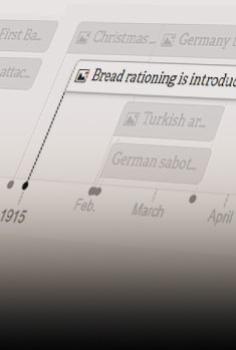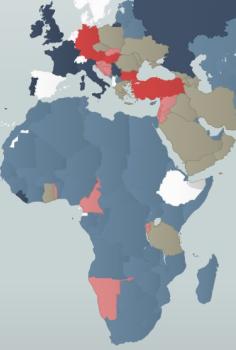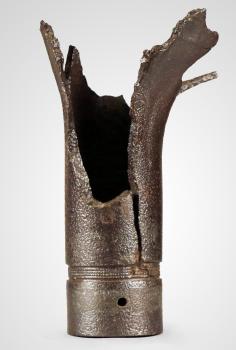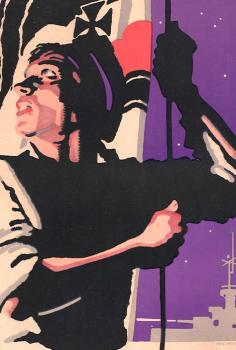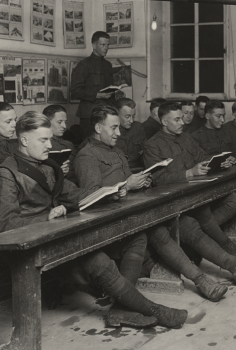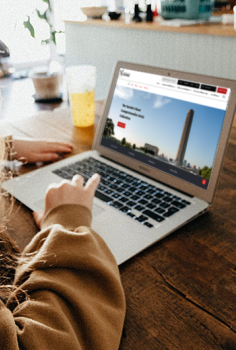- Who was Henry Gerber, and why is he important?
- The queer community and the liberatory thinking that accompanied it was born out of what two elements?
- What did the U.S. government give homosexuality by recognizing its existence?
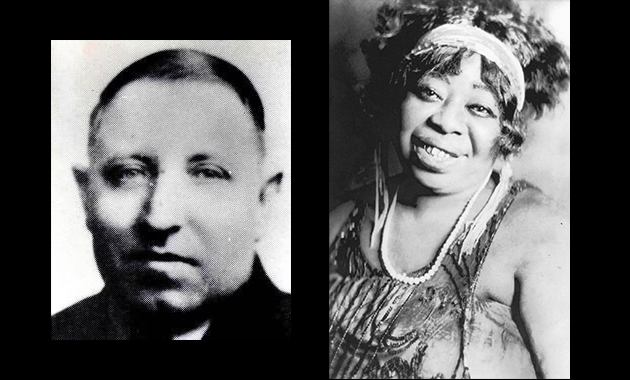
In these video clips, historian Dr. Caroline Radesky discusses the role that the First World War played in influencing modern gay rights. She starts by introducing Henry Gerber, who founded the first gay rights organization in the US in the interwar period, and tracks the evolution of (mostly) gay men who may have enlisted in the First World War as a form of suicide only to discover others like themselves, in addition to friendships, lovers, a thriving gay subculture in Europe, and a desire to create a place for themselves in American society. These soldiers returned to find discrimination, entrapment, and even arrest, but still went on to influence postwar change-makers and the modern gay rights movement.
Learning Objective: As a result of the following work, students will have a greater understanding of the role the experience of the First World War had on American queer soldiers, and how it impacted their ability to influence the modern gay rights movement.
The work: Students will watch 9 clips from a presentation made by Dr. Caroline Radesky, visiting Assistant Professor at the University of Iowa, for the National WWI Museum and Memorial in 2021. Through the use of a guided worksheet, students will visit reliable websites for additional background, define words and identify terms, and answer pre-, during, and post viewing questions as they view the video clips. A suggestion for an extension activity is also provided.
Resource Links
Henry Gerber - Part 1
This clip introduces Henry Gerber, founder of the first documented gay rights movement in the United States.
00:00:00:00 - 00:00:25:08
In 1917, as 24- or 25-year-old Henry Gerber (the man pictured here) attempted to commit suicide, ashamed of his love for men and thinking he could never pursue his feelings, he took poison in the hopes of ending it all. However, his attempt failed and he woke up in a Chicago asylum after police read his suicide note
00:00:25:10 - 00:00:53:14
where he admitted his desire. He endured electroshock therapy and was given pills to chemically castrate him. Emerging from the asylum, Gerber - who was a German immigrant - was given the choice of either entering an internment camp or joining the military and entering World War I. He chose the military. Working in Germany as a translator for the Allies, he traveled to Berlin.
00:00:53:16 - 00:01:29:08
There he met other same-sex desiring men, took part in a bustling queer subculture. He began reading queer publications, and he joined the first homosexual rights organization in the world. He returned to the U.S. in the early 1920s and made it his mission to bring what he termed homosexual emancipation to the United States, founding the first documented gay rights organization in the U.S. Gerber declared himself the Abraham Lincoln of the homosexuals.
00:01:29:10 - 00:01:59:21
It's very modest. But why I'm telling Gerber's story here, it's - his experiences illustrate the ways in which World War I opens up new sexual possibilities, queer communities, and ways of thinking about sexuality in relation to one's rights. This revolutionized the ways in which Americans thought about sexuality in relation to the state.
00:01:59:23 - 00:02:39:08
But this is not a reductive narrative of oppression and liberation. It's quite the contrary, actually. The queer community and the liberatory thinking that accompanied it was born out of the U.S. government's growing concern over same-sex desire and their homophobia. It was during and particularly after World War I that the U.S. government, growing in size, first recognized same-sex desire, gave it a name, and outlawed and prosecuted such sexual behavior.
00:02:39:10 - 00:03:22:19
You might be wondering now, how did this make room for early gay rights movements? And my answer to that is, while outlawing of queer desire was not liberatory, it did officially name such desire on a large scale - and by the U.S. government. This changed everything. By naming and defining such desire, the government gave homosexuality a sort of legitimacy by merely recognizing its existence. And through naming and defining it -
00:03:22:21 - 00:04:06:01
even in this negative context - queer folks had a collective identity and shared experiences of homophobic prejudice to organize around World War I brought same-sex desiring people together, exposing them to new people, new ideas that in turn helped them create the early homophile movements. Thus, I argue that World War I helped define, solidify, and make legible queer identities, creating a stable queer subject that serves as the foundation for these communities, cultures, and movements to take root through the 20th century.
Questions: Henry Gerber - Part 1
Treatment and U.S. Military Response
This clip discusses “treatments” for those accused of homosexuality, how the 1806 Articles of War were amended, and the consequences homosexuals in the military faced.
00:00:00:00 - 00:00:15:09
With people who were same-sex desiring now being understood as diseased, there were treatments, unfortunately. And we still have things like this today, very sadly.
00:00:15:11 - 00:01:01:08
So local municipalities began invoking laws making homosexuality illegal. This is, like I said, the local level and one thing that they're doing is also prescribing these treatments. So we have forced sexual intercourse with the opposite sex; institutionalization; imprisonment; castration; clitoridectomy; electroshock therapy, which is a very new thing they were experimenting with, as was lobotomy; and even encouraging suicide.
00:01:01:10 - 00:01:44:06
So when we think about World War I and the world in which this is happening: this is central. The upheaval of social systems, including gender, race, class and sexuality paralleled the upheaval and political unrest taking place in Europe, as the continent plunged into war. So just as sexologists are beginning to define and police sexuality, the U.S. government is influenced by these ideas and takes them on.
00:01:44:08 - 00:02:21:14
So it's not until World War I that sexologists’ ideas and pathologization of queer desire made its way into federal policy, particularly through the military. So with the Selective Service Act in 1917, the nation drafted 2.8 million men into service. The U.S. government grew exponentially with bureaucratic agencies that were created to support the war. The growth of the U.S. government led to the naming and policing of sexuality as never before.
00:02:21:16 - 00:03:02:06
For the first time in American history, the U.S. began screening for homosexuals by adopting the language of sexology that defined homosexuality as, quote, “a psychiatric perversion,” instead of policing acts, which the military did before. It was illegal to, well, it wasn't officially illegal, but was illegal to commit sodomy. But for the first time, they put this in the books.
00:03:02:08 - 00:03:43:08
Okay. So in March 1917, the U.S. revises the 1806 Articles of War, and it criminalizes assault with the intent to commit sodomy. Now, it's important to mention they do this a month before the U.S. declares war on the German Empire. That's not a coincidence. A month before, according to new military screening guidelines, doctors advised examiners “that the degenerate male physique as a whole is often marked by diminished stature
00:03:43:08 - 00:04:12:22
and inferior vigor.” So they are looking and trying to read bodies, just as sexologists were. The examiners were warned to watch out for recruits who, quote, “present the general bodily form of the opposite sex with sloping narrow shoulders, broad hips, excessive breast tissue, small penises and a lack of masculine hair and muscular markings.”
Questions: Treatment and U.S. Military Response
- List 4 examples of “treatments” for same-sex desire:
- With the Selective Service Act of 1917, how many US men were drafted into service?
- How was homosexuality defined by the sexologists of the period?
- How did the U.S. military revise the 1806 articles of war in March 1917?
- What could some soldiers accused of being homosexual by the U.S. military face?
The Experiences of Queer Soldiers
This clip discusses why queer men enlisted, what they discovered and how they reacted once they were in the military.
00:00:00:00 - 00:00:04:06
Queer men who wrote about their decision to join the war had vastly different explanations.
00:00:04:06 - 00:00:34:19
Some joined because they wanted a homosocial environment where they could be men, and they used very misogynistic language. Others wanted to prove their masculinity, prove they weren't effeminate. And many soldiers, like anyone else in the U.S, wanted to serve their country and used patriotic language to describe their decisions. And sadly, there are many accounts of same-sex desiring soldiers who wanted to join the military as a suicidal act.
00:00:34:21 - 00:00:59:07
One such soldier was Fred S. of Cleveland, Ohio, who wrote to German sexologist Magnus Hirschfeld. He wrote, “It is my greatest wish to get into the field as soon as possible and meet an honorable death, for otherwise I'll be compelled later on to make an end of my rotten life due to my homosexual tendencies for which I am not responsible.
00:00:59:09 - 00:01:51:15
It is better that my mother should be able to say, ‘My Fred died a heroic death for his country,’ than that people should say, ‘Oh, a suicide, eh?’” In the end, Fred got his peace, the peace he longed for, dying a month before the Armistice. The hate Fred felt for himself was not uncommon during this period. That internalized hatred affected many soldiers during this time, making suicide so common among queer folks. But regardless of their reason for joining, men from across the U.S. of various races, ethnicities, class backgrounds - from rural and urban settings - with differing sexual experiences were brought together by the war.
00:01:51:17 - 00:02:20:06
And, as historian Elizabeth Heinemann says, we need to consider the layering of young men's experiences, sexual or otherwise, as they travel to the front. For example, it's important to think about how this happens: so you start in your community of origin. You might not have ever met anyone else who is same-sex desiring. You could maybe not even know the term, or that there are other people like you.
00:02:20:06 - 00:02:45:14
That's something we see quite a bit. People writing, I didn't know there was anyone else like me. From there you would go to a base for training, often in a different region of the country where you first come into contact with people from all over the United States with different experience, different cultures. And you're exposed to these new ideas, and then you would continue your travels.
00:02:45:14 - 00:03:25:20
You go to England, even are meeting allied soldiers from other nations, and are exposed even more ideas. And then when you are on furlough, you are going to neighboring countries in attacked - I’m sorry - in contact with the locals. As Heinemann explains, the accumulation of these experiences in multiple settings, it shapes these enlisted men's behaviors and their identities. Now let's think about what these men are doing.
00:03:25:22 - 00:03:56:20
We connect through storytelling. That's all history is, is storytelling. And we connect through storytelling, that’s how we make meaning and relationships. These men are doing the same thing. They're sitting in their bunks or at their table, eating in trenches, sharing their experiences, telling stories from home, bragging about their sexual experiences, probably embellishing. And this is crucial for queer soldiers.
00:03:56:22 - 00:04:03:03
Like I said, many of them never met other men like them.
00:04:03:05 - 00:04:12:06
One soldier talks about how, “I never met one like me until I came to the Navy.”
00:04:12:08 - 00:04:37:09
And he says, “This is something I never did until I came in here.” Another serviceman discussed how he had to be very careful. He wasn't sure if same sex-desiring men - if he was reading them correctly. And they created these incredible friendships. Some created romances and supported each other through this heinous time in their life.
Questions: The Experiences of Queer Soldiers
- Why did queer men choose to enlist in the military during this period?
- What were some queer men surprised to find once they met other soldiers both at home and abroad?
- How did queer men react to one another during the War?
Queerness After the War: Culturally
This clip discusses American culture after the War, including the experience of lesbians, the Harlem Renaissance and drag balls.
00:00:00:00 - 00:00:41:06
So when these folks come home, they are thinking about their world differently. Many of them are disillusioned with society - they experience - after the horrors of war. We see the 1920s forever remembered for kind of the sexual freedom experimentation. We have the emergence of lesbian nightclubs in the cities like New York and Chicago, that emerge out of these new ideas about sexuality that come from the war.
00:00:41:06 - 00:01:03:21
We have lesbian nightclubs emerging in these cities where particularly Black jazz artists such as Ma Rainey, Gladys Bentley (who's pictured here), Bessie Smith, Lucille Bogan - performed music openly discussing lesbian desire and relationships. They were in the life, which is another term for kind of like being out of the closet.
00:01:03:23 - 00:01:29:11
And here's a map of the Harlem nightlife at the time. We have Gladys’s Clam House, a club where Gladys Bentley performed. The Lafayette Theater. These are all hot spots for queer entertainment and for queer communities to organize and come together and drink and dance and do all those fun things.
00:01:29:11 - 00:01:59:07
Another thing that emerges from this period, particularly for lesbian women, are the records. You don't have to be in Chicago or New York to hear this music. Here, we have Paramount. Paramount is putting out records from these lesbian, bisexual women, these artists. Here we have Ma Rainey's “Prove It on Me Blues.”
00:01:59:09 - 00:02:22:09
There are two cops in the back watching her flirt with two flappers. And the point of the song is like, the police can't do anything to me. They got to prove it on me. And she openly sings these songs. People could buy these records and listen to them no matter where they were. And it was that kind of out in the open.
00:02:22:11 - 00:02:26:20
Another great thing is that many of these women were bisexual,
00:02:26:20 - 00:02:54:15
And that that is not a new concept. We also have the publication of “The Well of Loneliness” by Radclyffe Hall. This emerges from her experiences as an ambulance driver during the war. She is a British author, and she writes a book about a kind of a coming-of-age tale of a woman who is same-sex desiring.
00:02:54:17 - 00:03:24:00
And this book was groundbreaking. This wasn't the first time this was covered, but it was groundbreaking because nobody died at the end. Usually in books, queer characters had to be punished for their desire, and that punishment usually came through death. In this book, though, it doesn't, and happily for the couple, no one died at the end, and that was groundbreaking.
00:03:24:02 - 00:03:56:08
It was made illegal, the book, in England; here in the U.S., it was not illegal. It was not taken off the shelves because there was technically no - there are no sex scenes in it. And that's how they measured propriety in literature. So because there - technically there are no sex scenes, people could get access to it. They could get it at the library, they could go buy it at the bookstore.
00:03:56:10 - 00:04:32:02
And this served as a foundational text for the lesbian community throughout the 1920s. Women in the 1970s, when the lesbian rights movements and feminist movements are really coming together, they are buying this book to read. So this has profound implications. We also have the Harlem Renaissance. So following the war with the Great Migration, we have folks of color migrating to cities
00:04:32:04 - 00:05:12:20
in the Northeast and the Midwest and the West Coast - eventually - and Harlem, of course. We have this incredible community of Black artists. And many of these artists, including the founder of the Harlem Renaissance Alain Locke, are same-sex desiring. And they write about their sexuality. And they write about their race in kind of taking an intersectional approach.
00:05:12:22 - 00:05:42:08
So we have people like Langston Hughes - like I said, Alain Locke, Angelina Grimké, all these folks - Bruce Nugent, whose work I use in the classroom - writing about sexuality. In the case of, like, Bruce Nugent and Angelina Grimké, they're both bisexual and both biracial mixed-race people. They write about not fitting in.
00:05:42:08 - 00:06:02:14
We also have drag balls emerging. And these are particularly in communities of color, though also in white communities, and they're very elaborate celebrations of gender nonconformity, gender non-binary, identities.
00:06:02:14 - 00:06:10:06
These definitely emerge from World War I. This is what soldiers were seeing when they were going to the clubs in Berlin.
Questions: Queerness after the War: Culturally
- What are the 1920s remembered for?
- Lesbian nightclubs opened in US cities, such as _____ and _____
- What is another term for being “out of the closet”?
- Companies such as Paramount put out records by lesbian and bisexual artists such as _____
- “The Well of Loneliness” by Radclyffe Hall was based on her World War I experience as _____
- How did the ending differ from other similar books?
- As part of what movement did Black and biracial Americans also write about their experiences with sexuality?
- What served as “very elaborate celebrations of gender nonconformity”?
Henry Gerber - Part 2
This clip returns to the story of Henry Gerber and his experiences after the war, including the organization he founded.
00:00:00:00 - 00:00:17:04
Now I'm going to end with who I began with: Henry Gerber. So after the war, Gerber comes home. He has all of his magazines, all of the experiences he had, the works of Hirschfeld.
00:00:17:06 - 00:00:50:23
He comes home and he decides that he wants to start a homophile movement in the U.S. He got a job with the Postal Service and he explained that, quote, “I had all this, but really felt the injustice with which my own American society accused the homosexual of immoral acts. I hated the society which allowed a majority, frequently corrupt itself, to persecute those who deviated from the established norms in sexual matters.
00:00:51:00 - 00:01:28:01
I thought to myself that if I succeeded, I might become known as the deliverer of the downtrodden, even as Lincoln. But I am not sure my thoughts were entirely upon fame. If I succeeded in freeing the homosexual, I too would benefit.” So, with the help of his boss, Gerber wrote a declaration of purpose in which he named his organization The Society for Human Rights, and he was able to gather a small membership, mainly of working-class queer folks.
00:01:28:03 - 00:01:52:16
Chicago's elite didn't want to be a part of it because they didn't want to get in trouble. They had more to lose, essentially. So we have John T. Graves, a same-sex desiring African American clergyman named president. Al Weininger, a man Gerber later described as “an indigent laundry queen,” was vice president, and then Gerber was the secretary.
00:01:52:18 - 00:02:15:07
It was expressly for gay men. They didn't want really anything to do with women, and they didn't want bisexual men in this organization because they thought that it would, quote, get too messy. So together they formed a three-point strategy for homosexual emancipation. First, they wanted to change society's view of same-sex desire through lectures and education.
00:02:15:09 - 00:02:48:23
Second, they aimed to keep the homosexual world in touch with the organization's publication. They are inspired by what they saw abroad, and they are thinking of their community as transnational - that, I think, is very important. And third, they sought to change legislation making same-sex desire punishable through law. So in a very bold move on their part, they submitted their constitution to the Secretary of State
00:02:50:07 - 00:03:25:12
in Illinois, and were furnished with a state charter. They were incredibly surprised, thinking “no one seemed to have bothered to investigate our purpose.” However, they were careful to make their purposes not too clear in the application. And afterwards, they started holding meetings. They created a newsletter, a publication called “Friendship and Freedom,” and they even sent a copy to Hirschfeld in Germany.
00:03:25:14 - 00:03:59:07
Sadly, the organization was short-lived. By the summer of 1925, all of the men were arrested. Their publication, Gerber’s journals, everything was confiscated. Weininger apparently did have a family. He was married. His wife found out, got upset and called the police. And Gerber spent all of his savings bribing lawyers to defend them and trying to get them out of jail.
00:03:59:09 - 00:04:34:19
He eventually does. So, after his release, Gerber loses his job with the Post Office, and he leaves Chicago for New York and starts living with some friends. They met during the war. He's encouraged to join the military again, and even though he was convicted for homosexual acts, he was enlisted again and served for 17 years.
00:04:34:21 - 00:04:54:17
He later died in 1972 in a Washington soldiers’ home. And he's remembered now when you go to Chicago. There's the Gerber/Hart archives. And there's a plaque outside his apartment where he was arrested. He's starting to be recognized for the work he did.
Questions: Henry Gerber - Part 2
- What did Henry Gerber decide he wanted to do upon his return to the U.S. after the War?
- What did he name his organization?
- Why didn’t Chicago’s elite join the Society?
- What two groups were not welcome in the organization?
- What was the name of their publication?
- Why did the organization end in 1925?
- How did Gerber respond?
- What did Gerber decide to do next?
Conclusion
This clip discusses the impact of the Great Depression, and how the work done in the pre-WWII period influenced the post-war United States.
00:00:00:00 - 00:00:41:21
We forget or don't know about these because the 1920s, of course, led into the Great Depression, and both Americans and Europeans alike blamed the liberalism and the sexual decadence of the 1920s for the fall, the Great Fall. Nightclubs closed in Harlem and Berlin, and policing of same-sex desire rose. These thriving cultures then had to turn into underground subcultures again and their legacy,
00:00:41:23 - 00:01:32:11
though not extinguished, also sort of went underground. But it's - it does a disservice to these folks to forget what they did. And I particularly like thinking about how their legacy lived on into the modern - 1970s - ‘60s and ’70s gay liberation movements. So in the 1950s, a young man named Harry Hay was cruising, and he met a man from Chicago who had recently moved to the area.
00:01:32:13 - 00:02:01:06
And he talked about this club he used to be in called the Society for Human Rights. And he talked about his ex-lover, Gerber. He described the group and its goals and its demise. Harry Hay was so inspired, he founded the Mattachine Society, which is credited as the organization to begin the modern LGBTQ rights movement. While the Mattachine Society was being established,
00:02:01:06 - 00:02:26:15
we have a young Radcliffe student around the same time in the 1950s pick up a copy of “The Well of Loneliness” and realize that she was not alone in her desire. Her name was Adrienne Rich, and she would go on to become one of the most influential feminist lesbian writers of the 20th century. So it's so important to be teaching this.
00:02:26:17 - 00:02:51:11
While scholars of queer history have often argued that the Second World War was the catalyst for modern LGBTQ rights movements, I think that such arguments ignore the impact of the First World War. We like the narrative of gay liberation being post-World War II because it gives us a clean story of people moving from hiding in the closet to marching in the streets.
00:02:51:13 - 00:03:42:22
However, as we know, history is never that neat and tidy. World War I and the world that emerged from it complicate this narrative and give us a richer understanding of what these folks went through and the world they created. And I think it's so important as educators for us to talk about world-making, and how even in these trying times, we - the queer community was able to thrive, to find each other, to make connections, to survive and thrive in a hostile world.
Questions: Conclusion
- What happened to same-sex desiring culture as a result of the Great Depression?
- Name two people who were inspired by the work done in the pre-WWII period:

